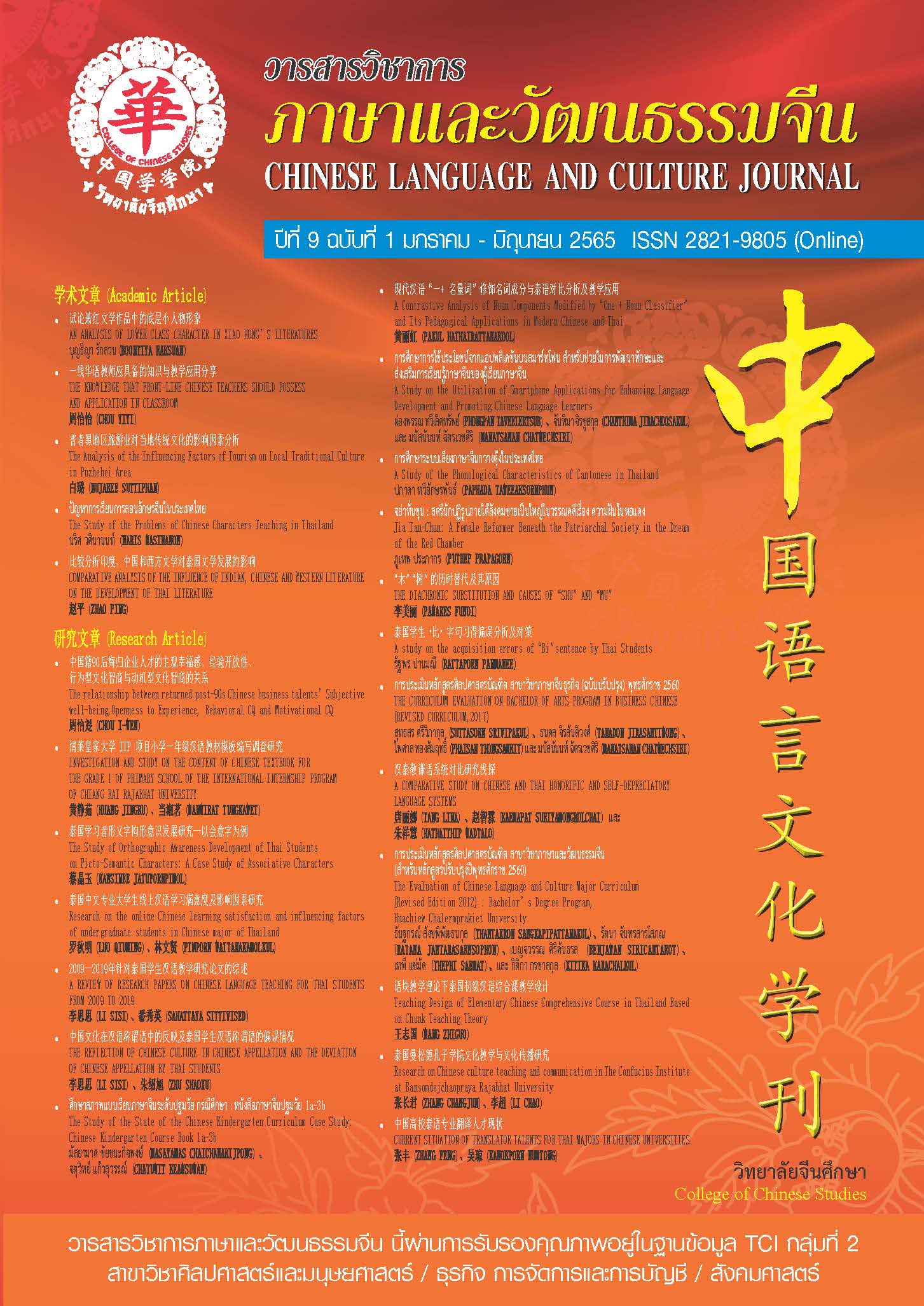现代汉语“一+量词”修饰名词成分与泰语对比分析及教学应用
A Contrastive Analysis of Noun Components Modified by "One + Classifier" and Its Pedagogical Applications in Modern Chinese and Thai
Abstract
ABSTRACT
Chinese and Thai are classifier languages. A distinctive feature of “numeral+classifier structure” is the use of numeral-classifier phrases evident in both languages. Of the several similarities and differences, the role of definite and non-definite principles, is highly significant. In Chinese, the grammatical meaning of the numeral "one" is also related to the principle of definite and non-definite. Thai numeral "one" can be placed in front of the classifier by the "one+classifier" structure and can be placed after the classifier by the "classifier+one" structure. However, these two structures have different expressive meanings and usages obtained through speech. Based on the definite and non-definite principles, this paper compares the semantics, syntactic and textual functions of Chinese and Thai's "one+classifier" structure. Moreover, this paper discusses how the Chinese learners (Thai students) use the Chinese "one+classifier" structure and the difference between "one+classifier" and "classifier+one" in Thai. Furthermore, it has tested whether the learners are influenced transfer by their mother-tongue languages and have errors in use, analyzes the sources of errors, and makes teaching recommendations based on the study results.
Keywords: one + classifier; definite; non-definite; Chinese-Thai contrastive analysis;
pedagogy of numeral-classifier phrases
References
参考文献
Charles N. Li, Sandra A. Thompson (1989), Mandarin Chinese A Functional Reference Grammar, London, England : University of California Press, Ltd.
One-Soon Her, Chen-Tien Hsieh (2010) “On the Semantic Distinction between Classifiers Measure Words in Chinese” Language and Linguistics, 11(3) page 527-551.
Prasithrathsint, Amara (2011), Syntactic Theories, Bangkok: Chulalongkorn University Press.
Ronald W. Langacker (2008), Cognitive Grammar a Basic Introduction, Oxford university press.
Sirasa Chalainanont (2019), “A Comparison of Chinese and Thai Classifiers and New Nouns Collocations” Journal of Translation and Interpretation Thailand (JTIT).
Wendan, Li (李文丹) (2004), “The Discours e Perspective in Teaching Chinese Grammar (华语层面的因素在中文语法教学中的地位)”, Journal of the Chinese Language Teachers Association.
王朝贵,王超.《有定、无定与汉语语序》[M].四川师范大学报,1987
李子瑄,曹逢甫.《汉语语言学》[M].正中书局股份有限公司,2009
邓守信《对外汉语教学语法》[M],台北:文鹤出版社,2018(103-121)
吕叔湘主编.《现代汉语八百词》[M].北京:商务印书馆,1999
李倩倩.《汉语母语者对汉语包含数量词的多项定语的系的研究》[J].,硕士学位论文,湖南大学,2019
屈承熹.《汉语认知功能语法》[M].台北:文鹤出版有限公司,1999
吴为善.《认知语言学与汉语研究》[M].上海:复旦大学出版社,2011
胡清国.《现代汉语构式“NP一个”》[J].汉语学报,2017(1)
陈俊光.《篇章分析与教学应用》[M].台北:新学林出版股份有限公司,2010
陈俊光.《英语为母语学习者对汉语连词的第二语言学的:华语作为第二语言地教学启示》[J].华语文教学研究,2018(4)
陈俊光.《对比分析与教学应用》[M].台北:文鹤出版有限公司,2019
赵元任着,吕叔湘译,《汉语口语语法》[M].北京:商务印书馆,1979
刘月华等着.《实用现代汉语语法》,北京:商务印书馆,2004
简恬佳.《现代汉语熟练定语的语法意义、篇章、语用分析及教学应用》[J].国立台湾师范大学硕士论文,2011
郭玫君.《华语教学语法:探讨量词与分类西的分级与教学排序》[J].台大华语文教学研究,2018
钟泰德.《汉泰语数量定语对比研究》[D].广西民族大学,2013
网络资料:
泰国国家语料库 (TNC:Thai National Corpus (Third Edition))
网址: http://www.arts.chula.ac.th/~ling/tnc3/
พจนานุกรม ฉบับราชบัณฑิตยสถาน พ.ศ. 2554(泰国国家词典):
Downloads
Published
How to Cite
Issue
Section
License
Copyright (c) 2022 Journal of Chinese Language and Culture, Huachiew Chalermprakiet University

This work is licensed under a Creative Commons Attribution-NonCommercial-NoDerivatives 4.0 International License.
บทความที่ได้รับการตีพิมพ์เป็นลิขสิทธิ์ของวารสารภาษาและวัฒนธรรมจีน มหาวิทยาลัยหัวเฉียวเฉลิมพระเกียรติ
บทความใน “วารสารวิชาการภาษาและวัฒนธรรมจีน” เป็นทรรศนะของผู้เขียนโดยเฉพาะ กองบรรณาธิการไม่มีส่วนในความคิดเห็นในข้อเขียนเหล่านั้น




